[The Fiction of a Doorframe]: Further Notes on Undocumentation
 Monday, December 19, 2016 at 9:19AM
Monday, December 19, 2016 at 9:19AM Amy Sara Carroll
[ PDF Version ]
Unscrew the locks from the doors!Draw a line not as a border, but as a bridge—a wall turned sideways—to paraphrase the philosopher-prison abolitionist Angela Davis.[1] Draw a line. Lines can be useful for naming lineage, alliance, solidarity, correspondence, and kinship. Such lines stand in stark contrast to lines employed to enclose the commons.
Unscrew the doors themselves from their jambs!
Walt Whitman, Leaves of Grass
In “‘No Humans Involved’: An Open Letter to my Colleagues,” the critic-playwright-novelist Sylvia Wynter redraws the lines of continental philosophy and genre theory when she suggests that young black men in the post-1960s US remain exceptionalized as the “Conceptual Other.”[2] Wynter’s observations complement her elaborations on “the genre of Man.”[3] They anticipate the cultural studies scholar Lauren Berlant’s injunction to perceive the present as a “temporal genre” running parallel to literary or artistic ones.[4] Berlant offers that the “emerging event” reappears as “the situation, the episode, the interruption, the aside, the conversation, the travelogue, and the happening.”[5]
Draw a line. The line as refrain marks constants that bridge ideas, arguments, and intuitions. The line as refrain marks political limits, new event horizons, and paradigm shifts. There are lines worth refraining from. There are lines worth repeating across millennia. We are broadcast lines that become refrains. The “tragedy of the commons,” the postcolonial studies scholar Rob Nixon explains, is a genre of Cold War neoliberal doctrines.[6] The loop of the militarized border as fence versus the figure of the migrant… The gate stormer and the gatekeeper are locked in Locke’s perpetual conflict, another tiresome master narrative. To enter the loop, scan its meter. We interrupt this program…
Any disturbance in the word-image environment is temporary but potentially game-changing. (To enter the loop, realize that you already were inside before you fully recognized yourself as a “sister outsider.”) The poet-philosopher of the Relation, Édouard Glissant observes, “Opacity is not derangement, it has its own transparency.”[7] In and against the twenty-four-hour newsfeed, strive for the happy medium of translucency. Lines that keep us or them off sides operate in one or possibly two dimensions. Flat, they warrant, beseech revision. Rigid, they invite relation.
Fall 2015, Patricia Zambrano, an MFA student in the Department of Visual Arts at the University of California, San Diego (UCSD), reframed prior meanings of the open studio and open door policies. Zambrano took her studio door off its hinges. Then, she invited every- and anyone to pass through its doorframe, use the space, and sit at the door repurposed as a long table.
Figure 1. Patricia Zambrano, Untitled (2015). Courtesy of artist.

Figure 2. Patricia Zambrano, Untitled (2015). Courtesy of artist.
Zambrano’s untitled gesture of radical hospitality unhinged some administrators who queried, “Who will pay for the damage?” Before I woke up one morning with lines from Walt Whitman ringing in my ears, Zambrano’s durational piece, coauthored with its publics, resonated in my mind’s eye with the “critical realist” and UCSD Visual Arts graduate Allan Sekula’s contextualization of his own documentary and conceptual practice’s development. In an interview with the art historian Benjamin H. D. Buchloh, Sekula submits:
The Southeast Asian war was very present, because San Diego was so heavily militarized. Navy jet fighters in jungle camouflage from the nearby Miramar Naval Air Station would buzz the campus after every demonstration, and often without even that provocation. Early on, in 1968-69, we would hide Marine deserters in the dorms after they jumped the fence at the big recruit training depot next to the San Diego airport... One could not avoid a sense of the insane depravity and general violence of the war, even on the other side of the Pacific from Vietnam… The university in this context was less of an ivory tower than one might imagine, especially since the San Diego campus of UC ranked third or fourth in the country in receiving research funds from the Pentagon. There was a whole “underground geography” to the campus: students living in utility tunnels, and using them for clandestine access to research labs while staging sit-ins.[8]
In the same era, the philosopher Herbert Marcuse received death threats for his teaching, ideas, and politics. Then Chancellor of UCSD William McGill details that then California Governor Ronald Reagan and the UC Regents feared the effects of Marcuse as professor and mentor of undergraduates.[9] Davis, Marcuse’s mentee, recounts that when students broke the glass of the door of the Registrar’s Office to stage a sit-in regarding the naming and curriculum of UCSD’s third college, administrators responded, “Who will pay for the damage?” Marcuse, a participant in the action, sent a money order.
There is much more that has been and will be “archived and repertoired” about student movements of the period at UCSD and beyond. There are many more lines that have been and will be drawn between campus activisms in the late 1960s and the early twenty-first century. For now, note that if Vietnam was the first heavily televised war, the student movements of the 1960s had a complicated relationship to media that is best understood as dialogic. In the case of UCSD, this dialogism was remediated two decades later in border art imprecated in a war of images leading up to the North American Free Trade Agreement’s implementation. The “illegal alien,” exceptionalized as another Conceptual Other, figures centrally in the era’s culture wars that continue to “Trump” the present.
The border studies scholar Claire F. Fox writes of early twentieth century postcards that featured both soldiers during the Mexican Revolution and their US spectators, situating all portrayed as participants in a border paradigm drama.[10] The political scientist Joseph Nevins notes that in the late twentieth-century “the most emblematic images associated with the war on ‘illegals’” emerged out of the San Diego-Tijuana corridor.[11] Draw a line. Zambrano’s gesture cites and re-sites another Bajalta California door repurposed after Marcuse’s down payment on a university for all.
Above ground, a quarter of a mile east of the Tijuana International Airport, a door once opened only from the Mexican side of the border. On the door’s frame, one hundred and thirty-four keys hung, each of them, an invitation to the undocumented “to cross the border with dignity.”[12] Richard Lou, the artist who installed the door and its frame on May 28, 1988, distributed additional copies of its keys in several of Tijuana’s unincorporated colonias. Border Door was removed by the US border patrol within two days of its appearance, and the Mexico-US border has been re/fortified across its nearly two thousand miles in the years of NAFTA’s implementation from 1994 to 2008. Still, Lou’s gesture persists, imaginary as geography or a portal through which we might time travel to envision what’s been framed as border art’s beginnings.
Before iconic images of Border Door were given second lives online, a single photograph by Jim Elliott was included in a multilingual anthology that serves as an auto-compilation of the actions of the Border Art Workshop/Taller de arte fronterizo (BAW/TAF) and responses to those actions (images, newspaper clippings, poems, drawings, and manifestos).[13] When Lou installed Border Door, he was a member of BAW/TAF.[14] In the 1980s, the collective gathered weekly to “discuss human rights violations by the border patrol, media depictions of Mexico and Mexicans and U.S. policy toward the South” and to develop strategies and tactics to “intervene directly in the social landscape of the border.”[15] BAW/TAF aspired to nothing more or less than the interruption of the border as “a state-market sponsored aesthetic project.”[16] The collective subscribed to the belief that, “Political actors do not merely respond to public pressure to ‘do something’ about drugs and illegal immigrants. Instead, they skillfully use images, symbols, and language to communicate what the problem is, where it comes from, and what the state is or should be doing about it,” years before the political scientist Peter Andreas made such a pronouncement commonsensical.[17] While the art historian Jo-Anne Berelowitz overstates the case that BAW/TAF put into wide circulation the terms “undocumented worker” and “undocumented immigrant,” her observations regarding the collective’s tactics nonetheless have furthered my own thoughts on undocumentation.[18]
The most literal-minded explication of the work accomplished by the prefix “un-” of undocumentation recalls border artists’ attentions to the undocumented. But, the conceptual and performative practices that I group under the rubric of “undocumentation” share both a common referent and a methodology that doubles down on negation. Put differently, the labor of fastening the prefix “un-” to a body of artwork does not engender a simple or singular disavowal of the status quo. Instead, the un- of undocumentation indexes a mode of erasure operative in the act of documentation proper. It illuminates what is hidden in plain sight. A range of millennial artwork produced in the Mexican-US borderlands responded to and reimagined the sometimes overlapping, sometimes distinct Mexican and US neoliberal logics of transparency that deployed the repeating island of the statistic, the percentile, the spread-sheet, the photograph, the exposé, and socioeconomic allegories of unification, with gestures that erased, stuck‐through, and overlaid the latter’s fastidious aesthetics. In this spirit, in BAW/TAF’s compilation, five pages before Border Door, BAW/TAF members catalogued and rubber-stamped “VERSION OFICIAL” a journalist’s sensationalist account of a San Ysidro-Tijuana high traffic zone of undocumented crossing. Inclusion of this coverage in the anthology performed an obvious function: BAW/TAF’s tactics were crafted relationally, in contradistinction to nativist public performances that cast the border as the ultimate guarantor of the autonomous art object of the nation-state on the open market.
Draw a line. Undocumentation as method versus “border as method” constitutes one sustained greater Mexican response to the spectacle of borderization at the join of the twentieth and twenty-first centuries.[19] Undocumentation’s unhinging affects hinge upon militant transdisciplinarity, vigilant multi-mediation, and even reluctant periodization. But, read expansively, undocumentation also corresponds to a more general intellect’s response to the New World Border’s reorder of things.[20] For instance, the un- of undocumentation resurfaces in the un- of the un-der-com-mons as it might relate to the sutured syllables of the university. Heed the observations of the poet-critics Stefano Harney and Fred Moten: There is no outside. The university’s insularity—disavowed now and previously—represents another threadbare narrative repurposed to curtail the circumference of our actions.[21]
To long is to lengthen the shadows cast by our dreams. To belong to the present is to pull taut the black and red threads of antedated pasts and histories of the future. Undocumentation represents neither a resigned embrace nor a wholesale renunciation of the imperial optics of documentary aesthetics. As radical critique and research method, it muddles the lines that divide politics/aesthetics, subject/object, public/private, self/Other, citizen/migrant … The poet-essayist-librarian Audre Lorde opens “Poetry is Not a Luxury” with the observation, “The quality of light by which we scrutinize our lives has direct bearing upon the product which we live, and upon the changes which we hope to bring about through those lives.”[22] While Lorde’s friend, the poet-essayist Adrienne Rich leaned heavily on “the fact of a doorframe,” what new alignments are enabled when we approach the door and its frame as inter/disciplining fictions instead?[23]
To write, to film, to make art or love translucently involves reimagining—time and again—the genres and mediums through which the very ideas of what constitute the human pass diffusely. Translucency is not a luxury. (Long live “utopian plagiarism”!) The lines of the undocumentarian meander: When I began this essay, I envisioned its close as an open-ended reference to a European call to repurpose the university as sanctuary for asylum seekers. In the short span of months between when I wrote this essay and when I received its page proofs, current events have led me to connect that call to post-presidential election calls for US university campuses to serve as sanctuaries for the undocumented. It would be a mistake to separate the urgency of these petitions from additional lines of flight.[24]
Spring 2016 administrators announced their decision to close and repurpose as classrooms the “classroom” of UCSD’s University Art Gallery (UAG). In response, the Collective Magpie, consisting of MR Barnadas and Tae Hwang (the first recipients of a shared MFA from UCSD’s Visual Arts Department), mobilized a community, occupying the site until the decision was reversed.[25] Collective Magpie hosted a series of “situations, episodes, interruptions, asides, conversations, travelogues and happenings” titled Dispossessed: A Call to Prayer and Protest, including Action 16: Invocation by Visual Arts MFA students Saúl Hernández-Vargas and Sindhu Thirumalaisamy.

Figure 3. Saúl Hernández-Vargas and Sindhu Thirumalaisamy, Action 16: Invocation (2016). Courtesy of Artists.

Figure 4. Saúl Hernández-Vargas and Sindhu Thirumalaisamy, Action 16: Invocation (2016). Courtesy of artists.
For the latter, Marcuse made a brief appearance at the entrance, on the threshold of the UAG in spectral solidarity with the space’s occupants. The circumstances of all of the aforementioned reclamations of the university and the border as genres are neither comparable nor disconnected. Draw a line.
Notes
[1] Angela Davis, Angela Davis: An Autobiography (New York: Random House, 1974), 347.
[2] Sylvia Wynter, “‘No Humans Involved:’ An Open Letter to my Colleagues,” Forum N.H.I. Knowledge for the 21st Century 1, no. 1 (Fall 1994): 43.
[3] Greg Thomas. “PROUD FLESH Inter/Views: Sylvia Wynter.” ProudFlesh: New Afrikan Journal of Culture, Politics, and Consciousness 4 (2006), cited in Alexander G. Weheliye, Habeas Viscus: Racializing Assemblages, Biopolitics, and Black Feminist Theories of the Human (Durham & London: Duke University Press, 2014), 23.
[4]Lauren Berlant, Cruel Optimism(Durham & London: Duke University Press, 2011), 4.
[5] Berlant, Cruel Optimism, 5.
[6] Rob Nixon, “Neoliberalism, Genre, and ‘The Tragedy of the Commons,’” PMLA 127, no. 3 (2012): 593-599.
[7] Édouard Glissant, “The Thinking of the Opacity of the World,” chapter 11 in Philosophie de la relation: Poésie en étendue (Philosophy of the Relation: Poetry in extension [2009]), trans. Franck Loric, reprinted in Frieze d/e 7 (Winter 2012): 77.
[8] Allan Sekula, “Conversation between Allan Sekula and Benjamin H.D. Buchloh,” in Allan Sekula: Performance Under Working Conditions, ed. Sabrine Breitwieser (Vienna: Generali Foundation, 2003), 30-31.
[9] Herbert’s Hippopotamus: Marcuse and Revolution in Paradise, dir. Paul Alexander Juutilainen, De Facto Fiction Films, US, 1996.
[10] Claire F. Fox, The Fence and the River: Culture and Politics at the U.S.-Mexico Border (Minneapolis & London: University of Minnesota Press, 1999).
[11] Joseph Nevins, Operation Gatekeeper and Beyond: The War on “Illegals” and the Remaking of the U.S.-Mexico Boundary (New York & London: Routledge, 2002), 3.
[12] Border Art Workshop/Taller de Arte Fronterízo, The Border Art Workshop (BAW/TAF) 1984-1989: a documentation of 5 years of interdisciplinary art projects dealing with U.S.-Mexico border issues (a binational perspective) = Taller de Arte Fronterizo (BAW/TAF) 1984-1989: documentación de 5 años de proyectos de arte interdisciplinario sobre asuntos de la frontera de Estados Unidos con México (una perspectiva binacional), (San Diego: Border Art Workshop/Taller de Arte Fronterizo, 1988), 46.
[13] For an overview of Lou’s work that includes images of Border Door, see Guisela Latorre, “Border Consciousness and Artivist Aesthetics: Richard Lou’s Performance and Multimedia Artwork,” American Studies Journal 57 (2012). Web. 5 May 2016. DOI 10.18422/57-05.
[14] Pronounced like some slant rhyme of Bauhaus, BAW/TAF was cofounded by David Avalos, Víctor Ochoa, Jude Eberhard, Michael Schnorr, Sara-Jo Berman, Philip Brookman, Isaac Artenstein and Guillermo Gómez-Peña.
[15] Guillermo Gómez-Peña, “A Binational Performance Pilgrimage,” TDR 35, no. 3 (Fall 1991): 37-38.
[16] Mary Pat Brady, Extinct Lands, Temporal Geographies: Chicana Literature and the Urgency of Space (Durham & London: Duke University Press, 2002), 83.
[17] 1 Peter Andreas, Border Games: Policing the U.S.-Mexico Divide, (Ithaca & London: Cornell University Press, 2000), 8.
[18] Jo-Anne Berelowitz, “Border Art Since 1965” in Postborder City: Cultural Spaces of Bajalta California, eds. Michael Dear and Gustavo Leclerc (New York & London: Routledge, 2003), 160-161.
[19] Sandro Mezzadra and Brett Neilson, Border as Method, or, the Multiplication of Labor (Durham & London: Duke University Press, 2013).
[20]Guillermo Gómez-Peña, The New World Border: Prophecies, Poems, & Loqueras for the End of the Century (San Francisco: City Lights, 1996); Roderick A. Ferguson, The Reorder of Things: The University and its Pedagogies of Minority Difference (Minneapolis & London: University of Minnesota Press, 2012). Note that Ferguson’s second chapter “The Proliferation of Minority Difference,” which treats UCSD’s Lumumba-Zapata movement, may be of particular interest to stalwart readers of these notes.
[21]Stefano Harney and Fred Moten, The Undercommons: Fugitive Planning & Black Study(Wivenhoe/New York/Port Watson: Minor Compositions, 2013).
[22] Audre Lorde, “Poetry Is Not a Luxury” in Sister Outsider: Essays and Speeches (USA: Crossing Press, 1984), 36.
[23]Adrienne Rich, The Fact of a Doorframe: Poems Selected and New, 1950-1984 (New York and London: W. W. Norton & Company, 1984.
[24]Sarah Shin, “They’re closing the borders, let’s open up our schools!,” Verso blog, www.versobooks.com/blogs/2631-they-re-closing-the-borders-let-s-open-up-our-schools (accessed May 2016); Elizabeth Redden, “Can a Campus Be a Sanctuary?,” Inside Higher Ed, www.insidehighered.com/news/2016/11/15/growing-movement-calls-universities-limit-their-cooperation-federal-immigration (accessed November 2016).
[25] See Benjamin Sutton, “UC San Diego Plans to Convert Art Gallery into Classrooms, Sparking Protests,” Hyperallergic, hyperallergic.com/301792/uc-san-diego-plans-to-convert-art-gallery-into-classrooms-sparking-protests/ (accessed May 2016); “UC San Diego Plans to Shut Down University Art Gallery,” Artforum, http://artforum.com/news/id=60287 (accessed May 2016).
Amy Sara Carroll is Assistant Professor of American Culture, Latina/o Studies, and English at the University of Michigan, Ann Arbor. Her first collection of poetry SECESSION was released by Hyperbole Books, an imprint of San Diego State University Press, in 2012. Her second collection FANNIE + FREDDIE/The Sentimentality of Post-9/11 Pornography was selected by Claudia Rankine for the 2012 Poets Out Loud Prize and published by Fordham University Press in 2013. She has been a member of the collective Electronic Disturbance Theater 2.0/b.a.n.g. lab since 2008. She collaboratively authored [({ })]The Desert Survival Series/La serie de sobrevivencia del desierto (The Office of Net Assessment/The University of Michigan Digital Environments Cluster Publishing Series, 2014). For more on undocumentation see Carroll’s first critical monograph REMEX: Toward an Art History of the NAFTA Era forthcoming from the University of Texas Press under the auspices of their Mellon Latin American and Caribbean Arts and Cultures Publishing Initiative.
 9
9 
Reader Comments